Amazing Landscapes of Ustyurt Plateau - Desert Between the Caspian and Aral Seas
Ustyurt is a plateau in Kazakhstan and Uzbekistan, located between the Mangyshlak and the Gulf of Kara-Bogaz-Gol in the west, the Aral Sea and Amu Darya delta in the east. The Ustyurt Plateau is a clay and stony desert with the total area of about 200 000 km². Also, there are areas of sandy desert. Very often Ustyurt is called the boundary separating Europe from Asia. The Ustyurt Plateau occupies a huge area between the Aral and Caspian Seas, and has a characteristic feature: the escarpment, a steep inaccessible slope with the height of about 150 m (the East Escarpment facing towards the Aral Sea, reaches 190 m). According to scientists, Ustyurt is the bottom of a dried-up sea, which existed here in the early and middle Cenozoic Era (21 million years ago).
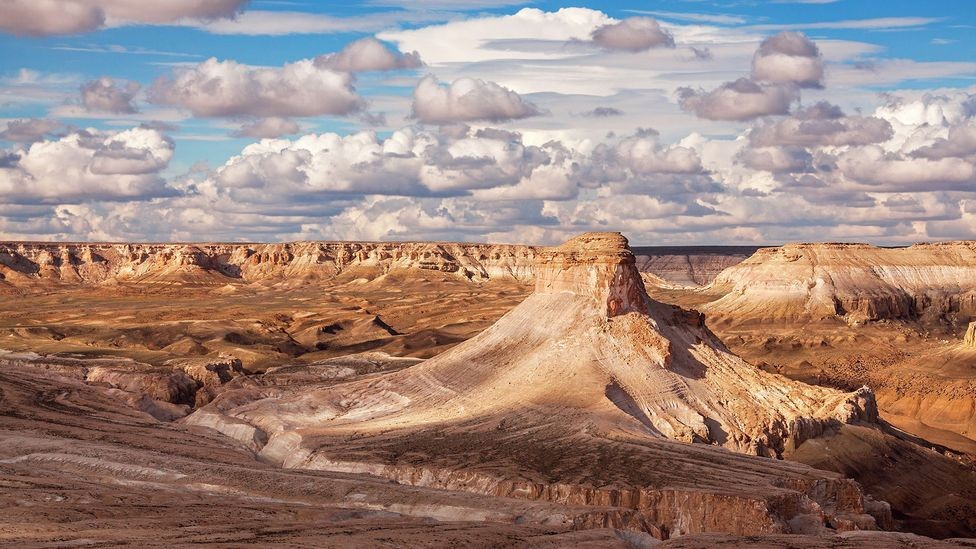 |
| Photo: BBC |
The word "Ust-Yurt" means "flat elevation". The large table Ustyurt Plateau lies on the territory of Kazakhstan and Uzbekistan, between the peninsula Mangyshlak in the west, the remains of the Aral Sea and the Amu Darya delta in the east. At present, the plateau rises above the plain at 180-300 meters. In some places it is incised to the surrounding plain by steep cliffs - chinks, up to 350 meters. One has to go many kilometers until he finds a place to lift up. The surface of the plateau takes the saline desert.
The geological age of the Ustyurt Plateau is estimated about 21-23 million years. The serious scientific study of it began only with the onset of the 1980s.
The most common physical characteristic of the Ustyurt is clay and clay-stony desert with groups of ribs or low-standing limestone karst formations and shallow cracks on the soil, grabens, local areas of fine gravel and - separately - sand.
In the early and mid-Cenozoic era the Ustyurt Plateau was the Tethys Ocean floor that subsisted between the ancient supercontinents of Gondwana and Laurasia. Limestones of the Ustyurt have many inclusions of shells, and some of their layers represent a real and solid shell rock. Other witnesses of ancient geological processes - the so-called stone balls, often partially destroyed, like bitten apples. They are spherical iron-manganese concretions which are formed usually on the seabed, at great depths.
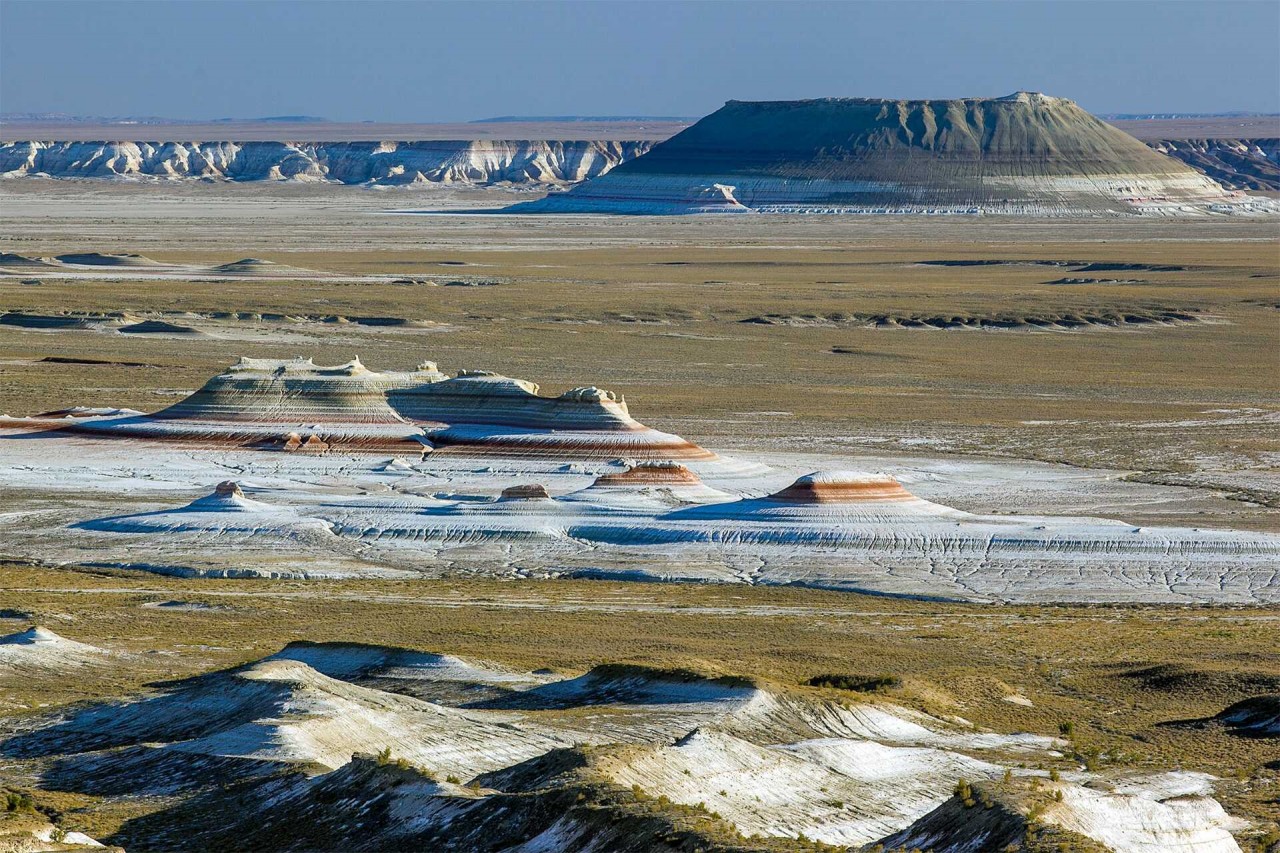 |
| Photo: Brodyaga |
The overwhelming number of them has an almost perfect spherical shape, and sizes range from two meters in diameter to the size of a cannon ball. It is strange how they got there. According to some scientists, it is the impact of the wind, which for millions of years has made its job, giving the stones the correct rounded shape.
The Ustyurt Plateau is especially beautiful during sunrises and sunsets. The chalk rocks are an impressive picture at sunrise and sunset, when the white rocks are painted in purple colors. At first sight you may overlok flora and fauna of the Ustyurt. Gradually, getting used to the unusual weather conditions, you can see colonies of gerbils, ground squirrels and jerboas. This area is inhabited by many birds of prey, vultures and eagles, who proudly sit on the rocks of escarpments. You can also meet the saiga, although it is doubtful whether you succeed to make a photo of these shy and very fast animals. But travelers can take a picture of Ustyurt argali in their natural habitat. The presence of wild horses in the Ustyurt is the most surprising. People say that in former times there were farms of Kazakh nomads, but the horses became wild, and settled down on the plateau, where live so far.
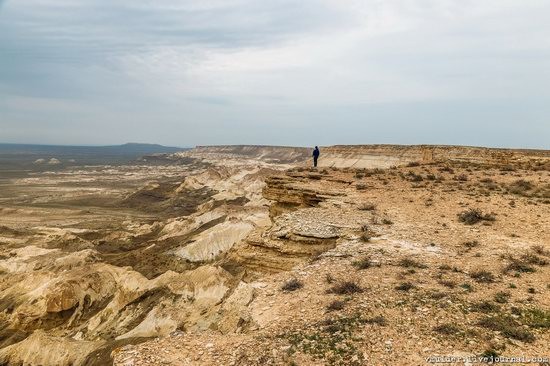 |
| Photo: aboutkazakhstan |
The ancient settlements on the Plateau Ustyurt
The other most significant discovery for travelers is that in hoary times these places were not deserted, here in the Middle Ages a part of the Great Silk Road, from Khorezm to Emba, the Caspian Sea and the lower reaches of the Volga took place. An impressive number of abandoned cemeteries, which are identified by towering over them mazars - gravestones, and underground temples demonstrates not only the fact that the caravanners had serious hardships along the way, but also that there were many, many people. And therefore, those who served the merchants in small towns with caravanserais, mosques and pens for the camels constantly lived on the plateau. From the ruins of the cities the relatively well-preserved remains of ancient Shahr-Vazir are most known.
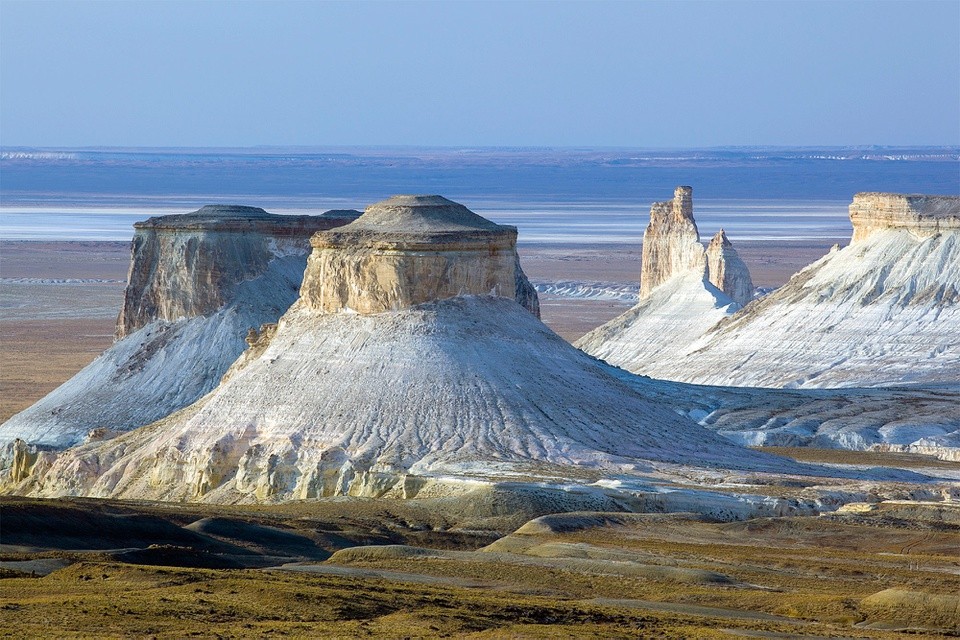 |
| Photo: Behance |
The traces of other cities are already open, but still unexplored. Much of these ruins, such as the abundance of abandoned wells, indicate that the living conditions on the Plateau Ustyurt in old times were not as harsh as they are now. With regard to time out of mind, the archaeologists found more than 60 Neolithic sites and remains of the ancient settlements on the Plateau Ustyurt of the Scythians-Sarmatians of the III-IV centuries. Then, as we recall, it was the era of the Great Migration (IV-VII centuries.); and the era also left its material traces on the Ustyurt Plateau. Not only time destroyed the medieval cities, there were Mongol hordes. This fact is also evidenced by archaeological finds.
What wonders magician-nature created on these scarce lands. Wind, sun, cold cut out of soft limestone such fanciful constructions and sculptures that even touching it, one does not believe that there were no human hands, and his genius.
Ustyurt Plateau vegetation
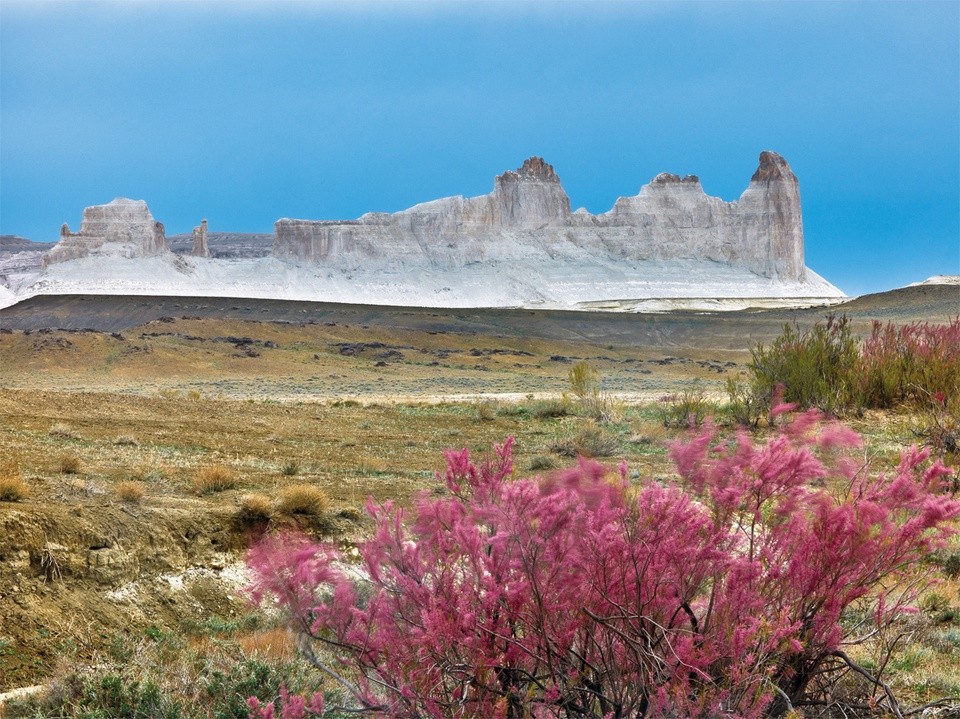 |
| Photo: 123rf |
Although the area of the plateau is 200,000 square kilometers, there are no rivers or lakes. Even the water obtained from the wells there is somewhat bitter and salty there. The flora is, therefore, quite scarce; the whole plateau is covered with poor wormwood or saltwort. However, people have not always avoided the plateau. They discovered over 60 settlement sites of the Neolithic Age. There are archeological evidence of the Scythians and Mongols staying in Ustyurt. A large number of caravan trade routes connecting Asia and Europe ran through the plateau.
Secrets of the Ustyurt Plateau
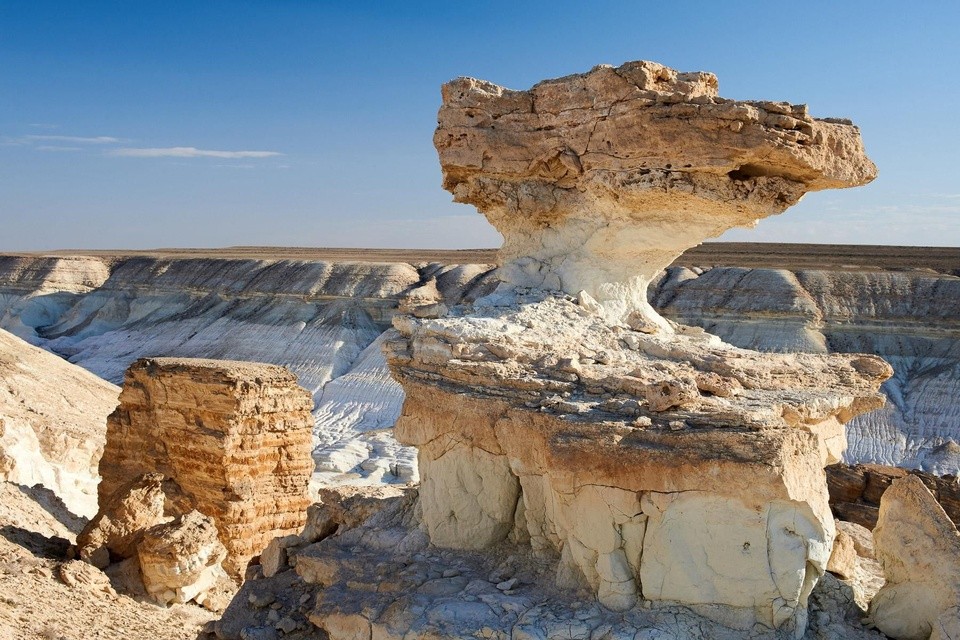 |
| Photo: Pinterest |
No archeological excavations and researches were for a long time conducted in the plateau because of its hard-to-cross terrain, remoteness and climate. However, during the archeological expedition in the Western Ustyurt in 1983 they discovered ancient cult structures called Bayte Cult Complexes. They consisted of large burial mounds, sacrifice tables and stone sculptures of men in fighting outfit. The examination of the finds proved that they belonged to the Dahae-Massageteans of the second half of the 4th - 3rd centuries BCE. Such complexes in Asian plains had never been discovered earlier. They had not been typical of nomadic tribes of those times, so the purpose of them remains unknown. Yet the most intriguing Ustyurt sight is the mysterious designs discovered by academic scholars during a helicopter flight over the plateau in 1986. Called ‘arrows’, they fill the area between the villages Beyneu and Say-Utyos. Similar designs were found only in the Nazca Desert, Peru. All the arrows are built from stones, and they point northward; each of them is 800 - 900 meters in length, 400 - 600 meters in width and up to 80 centimeters in height. The purpose of these structures, just like the purpose of the Nazca designs, is still unknown. There were a lot of various hypotheses, though: irrigation, cattle enclosures, mystical purposes related to Bayte Complexes… Whichever is closer to the truth, strange events often take place in Ustyurt Plateau. The locals tell about mysterious lights in the sky, very clear day and night mirages, etc. Sometimes the visitors of the plateau notice something like these by themselves; some people even go to Ustyurt Plateau especially for this experience. Whatever the aim of the visit, the natural grandeur of the plateau and its unique landscapes alone are certainly worth seeing.
 | The Historic Story of Sverd I Fjell, The Majestic Swords In Stone The Sverd I Fjell, an prominent monument created be the Norwegian sculptor Fritz Røed, are giant swords in stone located in Hafrsfjord, a suburb of ... |
 | Top 10 Most Beautiful and Must-Visit Caves In The World Caves are the creation of nature, charming any tourists with their mysterious and an air of danger, waiting for humans to explore the deepest secrets ... |
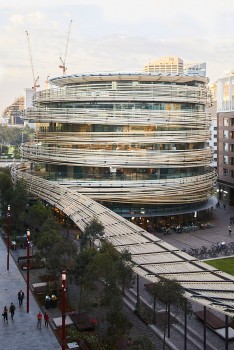 | Sydney: The Stunning “Exchange” Building Wrapped By Irregular Wooden Threads The Exchange building, one of the famous Japanese architecture Kengo Kuma and is wrapped by irregularly-arranged wooden threads to create softness on the building, has ... |
Recommended
 Travel
Travel
Vietnam Through Australian Eyes: Land of Flavor, Warmth, and Timeless Charm
 Travel
Travel
Strategies for Sustainable Growth of Vietnam’s Tourism from International Markets
 Travel
Travel
Vietnam Strengthens Its Presence On The Global Tourism Map
 Multimedia
Multimedia
Phong Nha-Ke Bang National Park Named Top Adventure Travel Site
 Travel
Travel
Vietnam Welcomes Record-High Number of International Visitors
 Travel
Travel
Luxury Train From Hanoi To Hai Phong To Be Launched In May
 Travel
Travel
Phong Nha Named Top Budget-Friendly Travel Destination for Spring 2025: Agoda
 Travel
Travel


